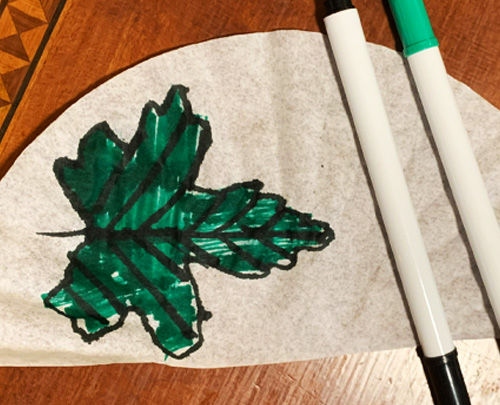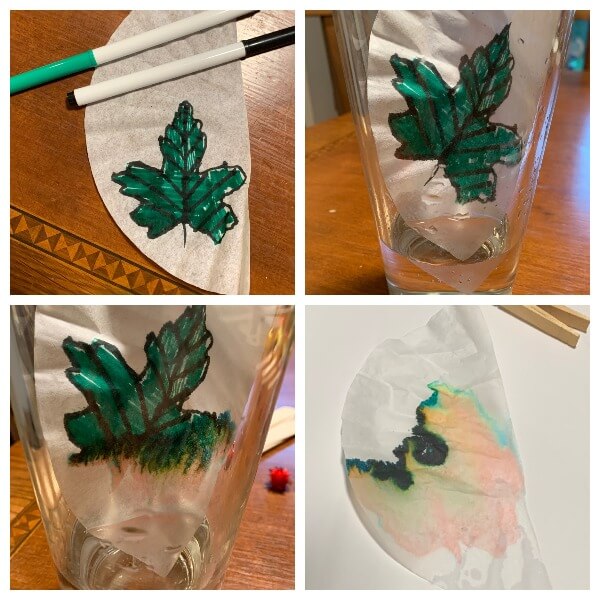Why Do Leaves Change Color in the Fall?

Leaf Activities for Preschoolers
Ages/Grades
Preschool, Early Elementary
Learning Domains
Science, Fine Motor
Materials
- • Leaves (real, plastic or silk)
- • Vinegar
- • Coffee filters (each student will get half a filter)
- • A tall, clear cup or jar
- • Black and green markers (washable - not permanent!)
- • Clothespins or tape
Ready, Set, Go!
 Gather leaves and make observations.
Gather leaves and make observations.- Exploration Questions: Which is the biggest leaf we have? Which is the smallest? Do any leaves have smooth edges? Do any leaves have bumpy edges or edges like a saw? How many green leaves do we have? What other colors do we have? Are any of them bendy or do any of them crumble when we bend them? Do the brown leaves smell different than the green leaves?
 Give each student half of a coffee filter. Allow them to choose a leaf from the collection. Using the BLACK marker, have them trace the leaf on the filter paper. Add veins and any other distinguishable feature. The demonstration works best if you draw the leaf towards the bottom of the filter paper- about half an inch from the bottom.
Give each student half of a coffee filter. Allow them to choose a leaf from the collection. Using the BLACK marker, have them trace the leaf on the filter paper. Add veins and any other distinguishable feature. The demonstration works best if you draw the leaf towards the bottom of the filter paper- about half an inch from the bottom.- Tip: draw a box with pencil where you’d like your students to trace the leaf.
 Lead a conversation about green leaves on trees.
Lead a conversation about green leaves on trees.- What happens to some green leaves in the fall?
- Some trees have leaves that go from green to yellow, orange, red, or purple. Then, the leaves fall off the tree. We call these trees deciduous trees.
- Has anyone seen a tree that doesn’t have leaves at all?
- Conifers (what we generally call pine trees) are trees that have needles instead of leaves and they don’t change colors or fall off in the autumn.
 Next, give each student a GREEN marker to color in their leaf. Their leaves are now the green leaves they’ve been seeing all summer.
Next, give each student a GREEN marker to color in their leaf. Their leaves are now the green leaves they’ve been seeing all summer. Fill a jar, glass, or even a bowl or tray with about an inch of vinegar. Fold the filter over the lip of the jar or the bowl and let just the bottom edge of the filter sit in the vinegar at the bottom. You may need to tape or clothespin the filter to the glass, so it doesn’t fall in. Make some observations and predictions. Watch for a bit as the vinegar travels up the filter. Leave the experiments alone for 10 minutes and check back. Leave for another ten minutes and check back.
Fill a jar, glass, or even a bowl or tray with about an inch of vinegar. Fold the filter over the lip of the jar or the bowl and let just the bottom edge of the filter sit in the vinegar at the bottom. You may need to tape or clothespin the filter to the glass, so it doesn’t fall in. Make some observations and predictions. Watch for a bit as the vinegar travels up the filter. Leave the experiments alone for 10 minutes and check back. Leave for another ten minutes and check back.- Exploration Questions: Use your senses - what do you see, hear, smell, and feel as you’re setting up the experiment? Was the filter dry or wet when you placed it in the jar? Is it still dry? What happens to the ink from your marker as the vinegar touches it on the filter? How do the leaves look different?

What’s happening?
- This was an example of paper chromatography. We separated the different pigments in the ink from the markers we used. The greens and blues in the inks dissolved more easily in the vinegar and traveled up the coffee filter while the less soluble (or less easily dissolved) reds and oranges stayed behind. While paper chromatography can be used to separate the different compounds from leaves, what you’ve done in this experiment is more of a demonstration better suited to littles. (If you have older and more patient students and want to try doing it yourself, there are directions in the resource section.)
- Leaves on a tree are green because of chlorophyll - a pigment that helps the tree to gather sunlight and make its own food. In the fall, when the days get shorter and there’s less light, the chlorophyll breaks down. When the green disappears, what remains are the yellows and oranges that are always there in the leaf. We just couldn’t see them with all the green before! Like our demonstration- these fall colors were always there, but until the vinegar moved the green (chlorophyll) out of the way, we couldn’t see them.
